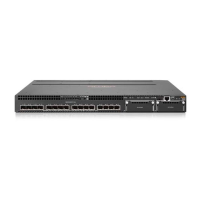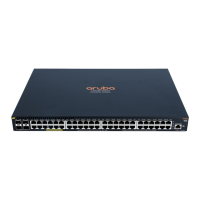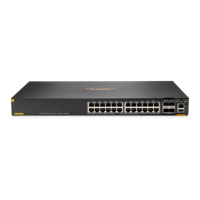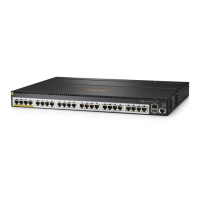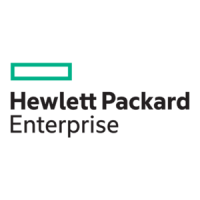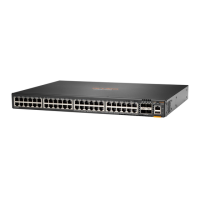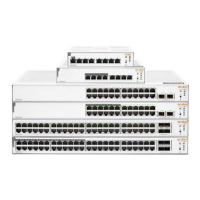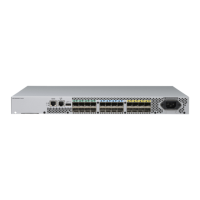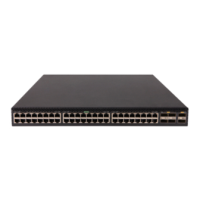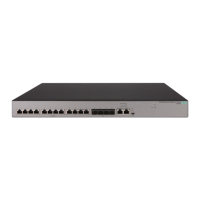Do you have a question about the HPE Aruba 3810 and is the answer not in the manual?
Describes multimedia traffic control with IP multicast and IGMP, reducing bandwidth usage.
Explains how to enable IGMP on the default VLAN or per-VLAN basis.
Details commands for configuring and displaying IGMP settings via the Command Line Interface.
Describes Protocol Independent Multicast Dense Mode (PIM-DM) operation and configuration.
Explains global and PIM context configuration for PIM-DM, including enabling IP multicast routing.
Details commands to enable or disable IP multicast routing globally on the switch.
Provides steps to configure PIM-SM on the router, including BSR and C-RP settings.
Covers global configuration context commands for supporting PIM-SM.
Details commands for configuring PIM-SM support within a VLAN context.
Explains the basic features of IP routing on the switches.
Details how to display the IP route table using the 'show ip route' command.
Explains how to configure the ARP cache timeout value using CLI commands.
Explains how to add static routes for IPv4 destinations.
Details how to add static routes for IPv6 destinations.
Describes how to view configured static route information.
Explains how networking switches drop packets destined for blackhole routes without logging.
Lists the commands for configuring and managing blackhole routes and debug logging.
Introduces RIP as an IP route exchange protocol using a distance vector approach.
Details procedures for configuring RIP parameters system-wide and per VLAN.
Explains how to enable RIP on the routing switch, including the default RIP version.
Details commands for configuring MD5 authentication for RIPv2 interfaces and keychain.
Explains RIPng for IPv6, supporting IPv6 addressing, prefixes, packet formats, and lengths.
Provides commands to configure, enable, or disable RIPng settings globally.
Covers enabling IP routing and global OSPF routing.
Details the command to enable IP routing globally on the switch.
Explains how to enable OSPF globally and enter the OSPF router context.
Explains how to create named lists of route prefixes for matching routes.
Details the syntax for creating prefix list entries with sequence numbers, permit/deny, and prefix lengths.
Explains how to display the content of prefix lists using the 'show ip prefix-list' command.
Explains how to enable IRDP globally or on an individual VLAN interface.
Provides the command to enable IRDP globally on the switch.
Details how to enable IRDP and configure its parameters on a per-VLAN interface basis.
Explains that DHCP relay is enabled by default and how to re-enable it if disabled.
Explains how to configure a gateway address for the DHCP relay agent.
Details how to add a DHCP server IP address for a specified VLAN.
Outlines steps to configure and enable UDP broadcast forwarding globally and per-VLAN.
Provides the command to globally enable or disable UDP broadcast forwarding.
Provides an overview of VRRP, its advantages, and supported versions.
Details how to configure VRRP globally and in VR contexts.
Explains how to enable or disable VRRP globally on the switch.
Introduces BGPv4 as the defacto internet exterior gateway protocol and its characteristics.
Details global BGP configuration commands for processes, router IDs, and timers.
Explains how to configure a BGP routing process and set up a distributed routing core.
Lists BFD commands, including per-session configuration in VLAN context.
Helps assign minimum transmit and receive intervals for BFD sessions.
Details how to enable BFD under OSPF for a particular IP (VLAN specific).
Provides instructions for accessing HPE support and information needed for assistance.
Explains how to access software updates and product documentation.
Introduces Aruba's mDNS Gateway solution for Apple Bonjour and Google Chromecast discovery.
Details Aruba's support for mDNS protocol as a server for Chromecast discovery.
Describes multimedia traffic control with IP multicast and IGMP, reducing bandwidth usage.
Explains how to enable IGMP on the default VLAN or per-VLAN basis.
Details commands for configuring and displaying IGMP settings via the Command Line Interface.
Describes Protocol Independent Multicast Dense Mode (PIM-DM) operation and configuration.
Explains global and PIM context configuration for PIM-DM, including enabling IP multicast routing.
Details commands to enable or disable IP multicast routing globally on the switch.
Provides steps to configure PIM-SM on the router, including BSR and C-RP settings.
Covers global configuration context commands for supporting PIM-SM.
Details commands for configuring PIM-SM support within a VLAN context.
Explains the basic features of IP routing on the switches.
Details how to display the IP route table using the 'show ip route' command.
Explains how to configure the ARP cache timeout value using CLI commands.
Explains how to add static routes for IPv4 destinations.
Details how to add static routes for IPv6 destinations.
Describes how to view configured static route information.
Explains how networking switches drop packets destined for blackhole routes without logging.
Lists the commands for configuring and managing blackhole routes and debug logging.
Introduces RIP as an IP route exchange protocol using a distance vector approach.
Details procedures for configuring RIP parameters system-wide and per VLAN.
Explains how to enable RIP on the routing switch, including the default RIP version.
Details commands for configuring MD5 authentication for RIPv2 interfaces and keychain.
Explains RIPng for IPv6, supporting IPv6 addressing, prefixes, packet formats, and lengths.
Provides commands to configure, enable, or disable RIPng settings globally.
Covers enabling IP routing and global OSPF routing.
Details the command to enable IP routing globally on the switch.
Explains how to enable OSPF globally and enter the OSPF router context.
Explains how to create named lists of route prefixes for matching routes.
Details the syntax for creating prefix list entries with sequence numbers, permit/deny, and prefix lengths.
Explains how to display the content of prefix lists using the 'show ip prefix-list' command.
Explains how to enable IRDP globally or on an individual VLAN interface.
Provides the command to enable IRDP globally on the switch.
Details how to enable IRDP and configure its parameters on a per-VLAN interface basis.
Explains that DHCP relay is enabled by default and how to re-enable it if disabled.
Explains how to configure a gateway address for the DHCP relay agent.
Details how to add a DHCP server IP address for a specified VLAN.
Outlines steps to configure and enable UDP broadcast forwarding globally and per-VLAN.
Provides the command to globally enable or disable UDP broadcast forwarding.
Provides an overview of VRRP, its advantages, and supported versions.
Details how to configure VRRP globally and in VR contexts.
Explains how to enable or disable VRRP globally on the switch.
Introduces BGPv4 as the defacto internet exterior gateway protocol and its characteristics.
Details global BGP configuration commands for processes, router IDs, and timers.
Explains how to configure a BGP routing process and set up a distributed routing core.
Lists BFD commands, including per-session configuration in VLAN context.
Helps assign minimum transmit and receive intervals for BFD sessions.
Details how to enable BFD under OSPF for a particular IP (VLAN specific).
Provides instructions for accessing HPE support and information needed for assistance.
Explains how to access software updates and product documentation.
Introduces Aruba's mDNS Gateway solution for Apple Bonjour and Google Chromecast discovery.
Details Aruba's support for mDNS protocol as a server for Chromecast discovery.
| Model | HPE Aruba 3810 |
|---|---|
| Stacking | Yes, up to 10 switches |
| Ports | 24 or 48 10/100/1000 ports |
| Power over Ethernet | Yes, up to 30W per port (PoE+) |
| Layer | Layer 3 |
| Management | Command-line interface |
| Features | Dynamic segmentation |
| Power Supply | Dual, hot-swappable power supplies |
| Security Features | Access control lists (ACLs) |
| Quality of Service (QoS) | Advanced QoS with traffic prioritization |
| VLAN Support | Up to 4, 094 VLANs |
| Layer 3 Features | Static routing, RIP, OSPF, VRRP, BGP |
| Energy Efficiency | Energy Efficient Ethernet (EEE) |
| Operating Temperature | 0°C to 45°C |
| Humidity | 15% to 95% non-condensing |
| Dimensions | 440 x 420 x 44 mm (1U) |
